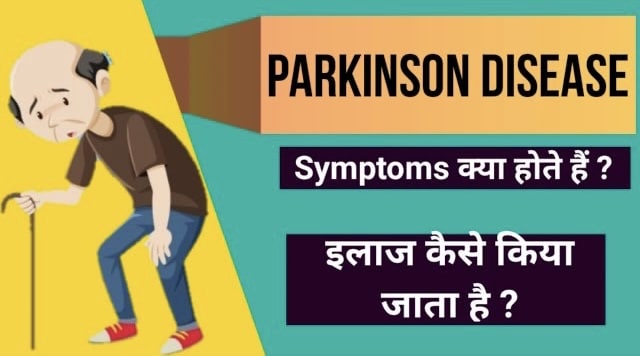What is parkinson’s disease ?
Parkinson’s disease is a neurodegenerative disorder which will affects the central nervous system.
Parkinson’s disease primarily affects the motor system, leading to a range of symptoms that worsen over time.
The exact cause of Parkinson disease is still not known, but it is believe to a combination of genetic and environmental factors.
In Parkinson’s, dopamine-producing cells will not work properly in a region of the brain called the substantia nigra.
Dopamine is a neurotransmitter that plays a crucial role in coordinating movement and its deficiency leads to the motor symptoms associated with the disease.
Symptoms of Parkinson’s disease
The primary motor symptoms are –
- Tremors: Typically, a resting tremor in one hand, which can also affect the legs, chin, or other parts of the body.
- Rigidity: Stiffness and resistance to movement in the limbs and joints.
- Bradykinesia: Slowness of movement, making it difficult to initiate and execute voluntary movements.
- Postural instability: Impaired balance and coordination, leading to problems with posture and frequent falls.
In addition to these motor symptoms Parkinson’s disease may also cause non-motor symptoms.
such as depression, anxiety, cognitive changes, sleep disturbances, and gastrointestinal issues.
There is currently no cure for Parkinson’s disease, but various treatment options are available to manage its symptoms.
It is important to note that Parkinson’s disease is a highly variable condition and its progression and symptoms can vary significantly from person to person.
Early diagnosis and comprehensive medical care are essential in effectively managing the disease and optimizing the individual’s well-being.
How is parkinson’s diagnosed
The diagnosis of Parkinson’s disease is primarily based on a thorough medical history, physical examination and assessment of symptoms.
There is no definitive test to diagnose Parkinson’s disease so the process involves ruling out other possible causes of similar symptoms.
A neurologist, a doctor specializing in disorders of the nervous system, typically makes the diagnosis.
They will begin by conducting a detailed evaluation, which may include the following steps:
- Medical History: The doctor will ask about the individual’s symptoms, their progression over time, and any relevant medical conditions or family history of Parkinson’s disease.
- Physical Examination: The doctor will perform a comprehensive neurological examination to assess motor skills, muscle tone, reflexes, coordination, and balance. They will also look for specific signs associated with Parkinson’s disease, such as tremors, rigidity, and bradykinesia.
- Response to Medication: In some cases, a doctor may prescribe a medication called levodopa or another dopamine agonist as a diagnostic trial. If the person’s symptoms significantly improve after taking these medications .
- Additional Tests: While there are no definitive tests for this disease, doctors may order certain tests to help rule out other conditions with similar symptoms. These tests may include brain imaging, such as a CT scan or MRI, to rule out other structural abnormalities or a DaTscan, which can help assess dopamine function in the brain.
It is important to note that the accuracy of the diagnosis can vary, especially in the early stages of the disease.
Some conditions, such as essential tremor or drug-induced parkinsonism, may mimic Parkinson’s disease symptoms.
Therefore, it is essential to consult with a qualified healthcare professional who specializes in movement disorders for an accurate diagnosis.
If you or someone you know is experiencing symptoms that could be related to the disease .
It is best to seek medical attention for a proper evaluation and diagnosis.
Treatment for parkinson’s disease
The treatment of aims to manage and alleviate symptoms, improve quality of life, and slow down the progression .
The specific treatment plan will depend on the individual’s symptoms, overall health and the stage .
It’s important to work closely with a healthcare professional, typically a neurologist specializing in movement disorders, to develop an individualized treatment approach.
Here are some common treatment options:
Medications:
Several types of medications are used to manage symptoms. The primary medications include:
- Levodopa: It is converted into dopamine in the brain, replenishing dopamine levels and reducing motor symptoms.
- Levodopa is often combined with carbidopa, which helps enhance its effectiveness and reduce side effects.
- Dopamine agonists: These medications mimic or acts like the effects of dopamine in the brain.
- They can be used as an alternative option or in combination with levodopa.
- MAO-B inhibitors: These drugs inhibit the breakdown of dopamine in the brain, increasing its availability and prolonging its effects.
- COMT inhibitors: They prolong the effects of levodopa by inhibiting its breakdown.
Physiotherapy:
Physiotherapy plays a important role in managing Parkinson disease. It will help in improving mobility, balance and flexibility.
Physical therapists may recommend specific exercises, stretching routines, and strategies to enhance movement and reduce the risk of falls.
Occupational Therapy:
Occupational therapy focuses on maintaining and improving daily living skills and independence.
It may involve techniques to optimize hand-eye coordination, dexterity, and cognitive functions.
Speech Therapy:
Speech and language therapists can help individuals with Parkinson’s disease manage speech and swallowing difficulties that may arise due to the condition.
They may suggest exercises, techniques, and strategies to improve speech clarity and swallowing function.
Deep Brain Stimulation (DBS):
In advanced cases of this disease that do not respond adequately to medications, deep brain stimulation may be considered.
It involves the surgical implantation of electrodes into specific regions of the brain, which deliver electrical impulses to help control abnormal brain activity and reduce symptoms.
Lifestyle Modifications:
Certain lifestyle changes can also contribute to the overall management of the disease Regular exercise, a balanced diet, and adequate sleep are important.
It may also be helpful to engage in activities that promote mental and emotional well-being, such as hobbies, social interactions and support groups.
It is important to note that treatment for this disease is highly individualized, and the effectiveness of different approaches can vary from person to person.
Read our other medical articles
